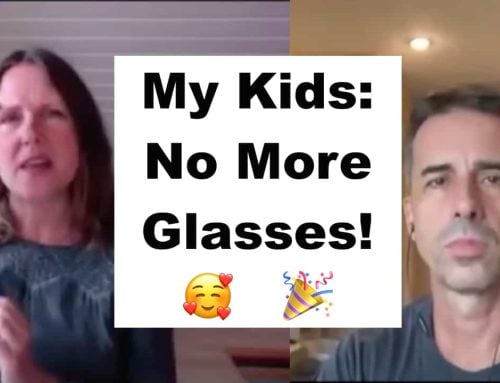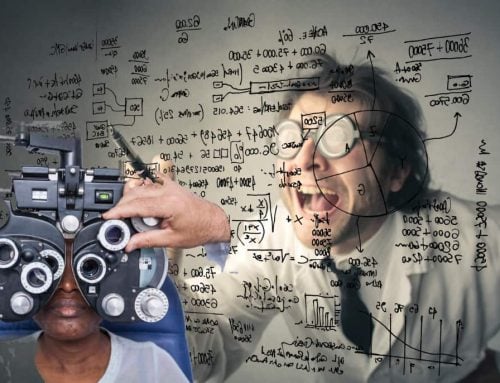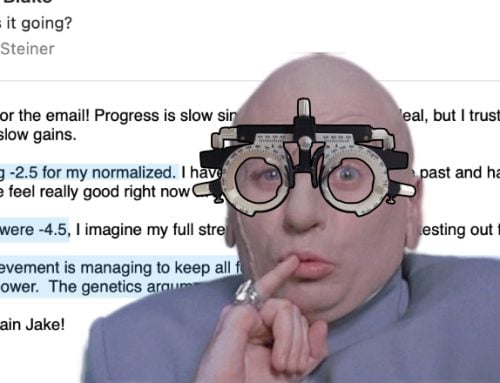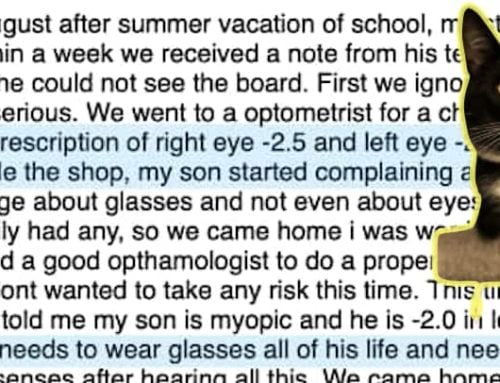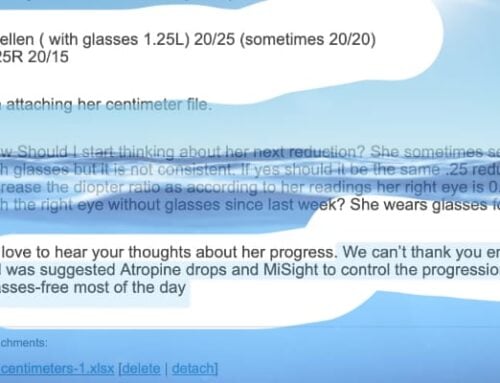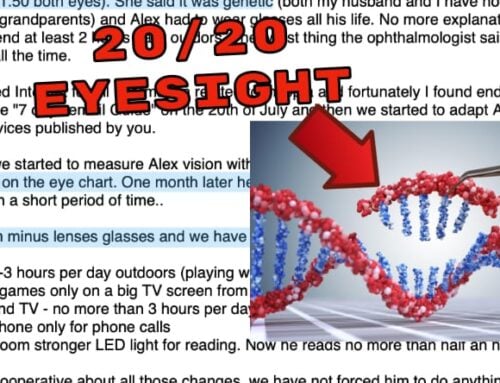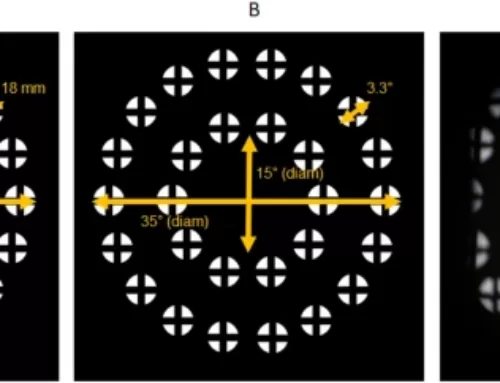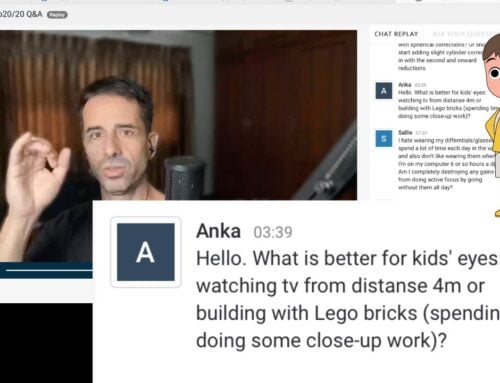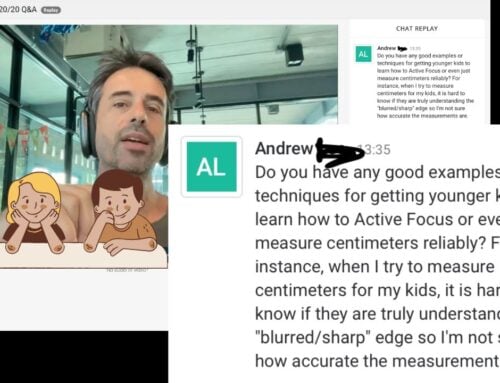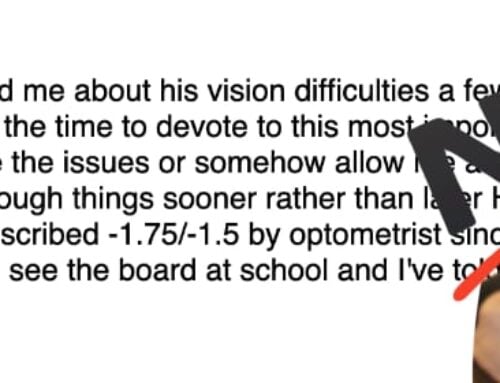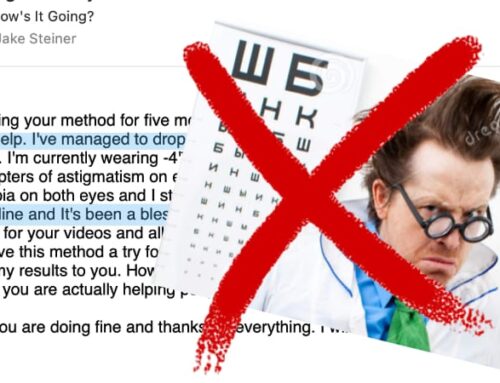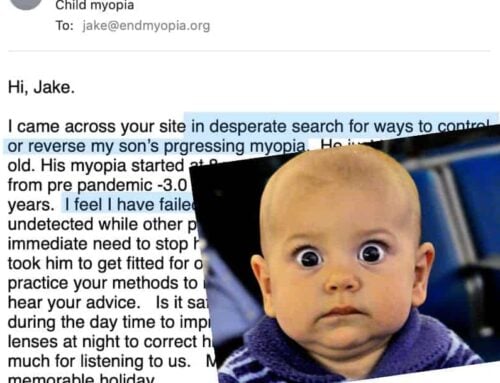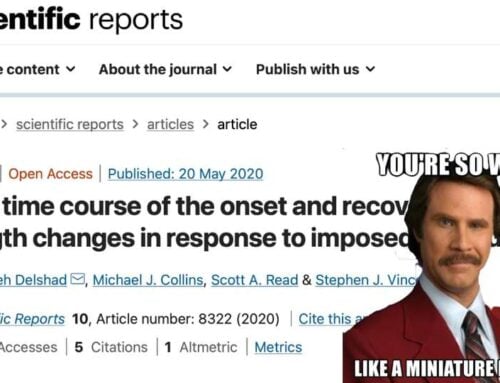I neglected yesterday’s post duties. Let’s make up for it today, with some <3 science.
—
As always, I show you studies published in the very journals meant for optometrists and ophthalmologists. The irony in all of this should be self evident.
First up today, the Journal of the College of Optometrists.

What you should take note of as you read these things, that these are journals as far removed from pseudo science or anti optometry rhetoric as you can get. This is straight old school mainstream starched white shirt academia. And yet…
Extrapolation of
[…] to humans predicts that natural emmetropization will be inhibited in neonates by early intervention with prescription lenses, and that refractive correction of myopia will lead to accelerated progression.In other words (bolded), wearing glasses to correct myopia, will create more myopia.
That’s verbatim, straight from the optometry-industry-publication-horse’s mouth. And if you read this, really read it, it should be fairly shocking of an admission. The treatment creates more of the problem, and they admit to finding it, over and over.
Can we just call it an “oops”?
The only difference between your darling friend Jake and mainstream optometry publishing? I take these passive findings several steps further towards awesome, and give you strategies to take action to reverse your own myopia.
Here’s the whole summary from the article, titled “Active emmetropization — evidence for its existence and ramifications for clinical practice”.
There is increasing evidence from animal studies in support of the concept of an active emmetropization mechanism which has potentially important clinical ramifications for the management of refractive errors.
Recent research into retractive development and emmetropization is reviewed, with emphasis given to work involving the chick, tree shrew and monkey, which represent the three most widely used animal models in this field. The findings of this research are reviewed in a clinical context.
Compensatory eye growth responses to focusing errors imposed by lenses represent the most compelling evidence for active emmetropization. These observations are complemented by other evidence showing recovery from induced refractive errors such as form-deprivation myopia. Of the animals listed above, chicks show the most impressive emmetropization, being able to compensate fully (using choroidal and scleral mechanisms) to lens powers ranging from +15 D to -10 D. The range of lens powers eliciting appropriate compensatory responses is narrower in the tree shrew and monkey, and the response patterns generally are also more complex to interpret. These data relate to young animals and together indicate refractive plasticity during development. Extrapolation of these findings to humans predicts that natural emmetropization will be inhibited in neonates by early intervention with prescription lenses, and that refractive correction of myopia will lead to accelerated progression.
This convincing evidence for active emmetropization warrants due consideration in developing clinical management strategies for refractive errors.
If you’ve been following the blog for the past few years, you’ve already seen quite a few of the animal studies referenced. None of this is really news.
I’m putting together these articles every once in a while, since I persistently get e-mails asking why there are no studies on these subjects. There are. Thousands. Over the past five plus decades. There’s just no money in prevention, and most people do like a quick fix, no questions.
And while there are very few if any published studies referring to your resident greatness and the complete defeating of myopia, academia does like to graze the perimeters of the endmyopia temple of wisdom.
Let’s look at another one. Nuggets of gold are hiding in this as-usual narcolepsy inducing titled, “Effect of Dual-Focus Soft Contact Lens Wear on Axial Myopia Progression in Children“.
As you read on, keep in mind the boundaries of what they’re going to publish:
There are some unwritten rules. First of course, studies require funding. Authors may be scrutinized for previous published materials before getting greenlit for new projects. Stepping over the line, biting the proverbial (lens manufacturing) hand, might mean not just no funding, but also no publishing. And as the saying goes, publish or perish. Due to this, and also due to the perceived heresy of the wisdom you receive here at endmyopia, there’s always a lot of dancing around the obvious. Take a look:
Myopia progression and eye elongation were reduced significantly in eyes wearing DF lenses. The data suggest that sustained myopic defocus, even when presented to the retina simultaneously with a clear image, can act to slow myopia progression without compromising visual function.
What are they saying here?
Same as what you know already, and what science has known since the dawn of proper vision science. Minus lenses cause axial elongation of the eyeball, and more myopia.
Anytime, and I really do mean *anytime* you reduce or eliminate excessive minus, myopia progression slows, or stops.
Woohoo. Color us shocked.
Also note that any study always has to have a potential marketable component. You can’t ever straight up say “hey, let’s just *not*”. That won’t fly. Studies are feelers for new potential products. That’s how you get funding.
So instead of eliminating the silliness of lenses, most studies you find on the subject, use *different* lenses.
Things that are complicated and require a pouty professional in a white lab coat, and expensive prescriptions either way. Something that says, “see, you still need us”. But between the lines, if read even with a modicum of awareness, the biological facts are pretty self evident. Minus creates more myopia. Period, end of story.
Here’s the full summary of the study:
Purpose
To test the efficacy of an experimental Dual-Focus (DF) soft contact lens in reducing myopia progression.
Design
Prospective, randomized, paired-eye control, investigator-masked trial with cross-over.
Participants
Forty children, 11–14 years old, with mean spherical equivalent refraction (SER) of −2.71±1.10 diopters (D).
Methods
Dual-Focus lenses had a central zone that corrected refractive error and concentric treatment zones that created 2.00 D of simultaneous myopic retinal defocus during distance and near viewing. Control was a single vision distance (SVD) lens with the same parameters but without treatment zones. Children wore a DF lens in 1 randomly assigned eye and an SVD lens in the fellow eye for 10 months (period 1). Lens assignment was then swapped between eyes, and lenses were worn for a further 10 months (period 2).
Main Outcome Measures
Primary outcome was change in SER measured by cycloplegic autorefraction over 10 months. Secondary outcome was a change in axial eye length (AXL) measured by partial coherence interferometry over 10 months. Accommodation wearing DF lenses was assessed using an open-field autorefractor.
Results
In period 1, the mean change in SER with DF lenses (−0.44±0.33 D) was less than with SVD lenses (−0.69±0.38 D; P < 0.001); mean increase in AXL was also less with DF lenses (0.11±0.09 mm) than with SVD lenses (0.22±0.10 mm; P < 0.001). In 70% of the children, myopia progression was reduced by 30% or more in the eye wearing the DF lens relative to that wearing the SVD lens. Similar reductions in myopia progression and axial eye elongation were also observed with DF lens wear during period 2. Visual acuity and contrast sensitivity with DF lenses were not significantly different than with SVD lenses. Accommodation to a target at 40 cm was driven through the central distance-correction zone of the DF lens.
Conclusions
Dual-Focus lenses provided normal acuity and contrast sensitivity and allowed accommodation to near targets. Myopia progression and eye elongation were reduced significantly in eyes wearing DF lenses. The data suggest that sustained myopic defocus, even when presented to the retina simultaneously with a clear image, can act to slow myopia progression without compromising visual function.
See what’s going on there?
If you take the time to get familiar with the rules of these studies and get a sense of the lingo and terminology, it’s nothing short of comedic, reading these things.
“So, hey. What if we just used *less* of the stuff? Look, see, less myopia. And we can sell this, for, you know, more money. Anyway, what shall we call it, the *less-of*?”
A new darling friend of the blog will be doing the first ever Jake podcast interview next week (barring sudden child birth messing up the schedule). For details and other things, follow me on the new Twitter bits.
Cheers!
-Jake



